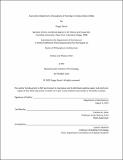A Syncretic Modernism: Articulations of Painting in Turkey (1910s-1940s)
Author(s)
Demir, Duygu
DownloadThesis PDF (23.32Mb)
Advisor
Jones, Caroline A.
Terms of use
Metadata
Show full item recordAbstract
This dissertation is a critical history of modern art in Turkey, focusing on two generations of artists that came to articulate the parameters of painting in the late Ottoman Empire and the Turkish early republic. I follow the trajectories of a selection of artists who became leading figures in the Turkish art world over the course of their careers: These painters contributed to the artistic discourse not only through their work, but also through their positions as teachers, gatekeepers, and tastemakers. While their artistic trajectories set these two generations apart, they had just as much in common: they all rose up to what they defined as the academicism of their teachers, formed generational alliances, opened exhibitions, served as missionaries of the new nation, attempted to find perpetual principles for a Turkish art, struggled to find their artistic identities, and got labeled as European imitators. Pressed between divergent expectations from the outside as well as the inside, they oscillated between the search for the universal and striving for the local.
Oil painting had been a marker of modernity and social emancipation already in the Ottoman period; it was a vessel in attaining a level of civilization contemporaneous with the rest of the world (read Europe), a crucial tool in the ongoing pursuit of technological modernity, and also a mode of self-expression. In the early years of the republic, the Turkish intelligentsia strove for a cultural synthesis that would take its forms from the West, whereas its content would be determined by local sources. Yet, painting is neither a technology that can be borrowed, nor simply a manifestation of cultural essence but a repository for both, and much more; it resists being delineated into strict categories of form and content. The task of this project is to chart the different ways in which the late-Ottoman and Turkish painters who embraced the medium of painting attempted to position themselves within this conundrum, oscillating between emulation and invention. Charting how this predicament manifested itself in the work of these artists and the discourse it generated is also revelatory of the paradox of Turkish modernization itself, with implications for our understanding of modernisms around the world and for emerging theories of the tensions between modernist art and the modernization of nation-states. Attending to the specific historical, political and aesthetic realms of this thirty-year period, this dissertation analyzes how the two generations of painters negotiated these challenges. In this dissertation, I read the paintings, exhibition histories, institutional shifts, artist testaments, articles and reviews that shaped Turkish painting over the period in question as articulations of a complex system, presenting a counter-history of one modernism among many. This, I argue, strove for synthesis but ultimately remained syncretic—a strategic amalgam of Turkey’s highly polyglot reality that refused to be smoothed into a synthetic whole.
Date issued
2022-09Department
Massachusetts Institute of Technology. Department of ArchitecturePublisher
Massachusetts Institute of Technology